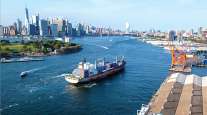Senior Reporter
Ports Record Steep Drops in April Cargo

[Stay on top of transportation news: Get TTNews in your inbox.]
The slump in container volumes at ports on the East and West coasts continued in April as some of the largest facilities saw year-over-year double-digit drops.
The Port of Los Angeles reported a 22.5% decline when measured against 2022’s strong year. The port processed 688,109 20-foot-equivalent unit containers compared with 887,357, or a decline of more than 199,000 TEUs.
“A cooling global economy, warehouses laden with aging inventory and prolonged West Coast labor negotiations have all contributed to a slowdown in trade,” Port of Los Angeles Executive Director Gene Seroka said. “If economic conditions improve and we get a labor deal in place, that will help improve volume the second half of the year. We are prepared for the next cargo surge, whenever it comes.”
The port also announced that Yusen Terminals, one of its terminal operators at the facility, is set to receive the first five commercially available zero-emission top handlers later this year. Seroka said the battery-electric top handlers, which are essential to container terminal operations, have been in demonstration mode at the port complex.
ICYMI: Alan McCorkle, President and CEO of Yusen Terminals (YTI), joins Port of Los Angeles Executive Director Gene Seroka for a discussion about prospects for improved volumes, supply chain challenges and innovations. https://t.co/LW1cLlwOXX pic.twitter.com/0dfQGOi8LS — Port of Los Angeles (@PortofLA) May 19, 2023
The adjacent Port of Long Beach also reported a 19.6% year-over-year decline as the complex moved 659,049 containers in April compared with 820,718.
“The unprecedented consumer demand we saw at the height of COVID-19 has diminished and cargo flows are now closer to pre-pandemic levels,” Port of Long Beach Executive Director Mario Cordero stated. “We expect slow growth in the second half of 2023 as retailers continue to clear surplus inventory from their warehouses.”
The Port of Oakland processed 180,482 TEUs, compared with 188,442 for a 4.2% decline from 2022.
Meanwhile, efforts to build a multibillion-dollar entertainment and retail complex at the port’s unused Howard Terminal with the centerpiece being a new home for Major League Baseball’s Oakland Athletics have stalled. The team recently signed a purchase agreement for land in Las Vegas after the city and team could not reach an agreement.
Oakland Mayor Sheng Thao says she is willing to reopen negotiations with the team.
Ports in Seattle and Tacoma, Wash., which are operated by the Northwest Seaport Alliance, reported a 12.8% decline to 232,321 containers in April compared with 266,635 a year ago.
While volumes slumped, the port still is planning for expected growth. The facility in June will receive and install two additional Super-Post-Panamax cranes, capable of handling the biggest cargo ships.
The port also announced auto volumes are up 110% as automakers Kia and Hyundai expanded shipments out of the Northwest.
Volume at Port Houston also slowed by 8% in April to 307,879 containers compared with 334,493 a year ago.
The decline is significant because the complex until recently had recorded several consecutive year-over-year and month-over-month increases in container volume, and now the slowdown appears to be impacting that facility.
@Port_Houston jumped from 7 to 5 in the ranking of top U.S. container ports in terms of TEUs handled in 2022, Port Houston Chairman Ric Campo announced at the Port Commission regular meeting. Read more about Port Houston, the fastest growing port in the US https://t.co/roxwsy1x8G pic.twitter.com/tXYPQcvJbG — Port Houston (@Port_Houston) May 12, 2023
Even with the drop-off, Port Houston became the fifth-busiest container port in the country in 2022 after being ranked seventh.
On the East Coast, the Port of Savannah, Ga., processed 408,686 containers in April, its second-highest month this year. Still, it marked a 17.5% year-over-year decline from 495,782. However, that’s up more than 11% from 367,880 in March, which was the slowest month for the port since July 2020.
Georgia Ports Authority also announced it secured federal approval to develop its inland port rail hubs, with environmental approval for a rail terminal near Gainesville, about 60 miles northwest of Atlanta. Officials say 600 round-trip highway miles will be offset for every container moved by rail.
@GaPorts has received environmental approval for a new inland terminal near Gainesville, GA. The new hub will open with volumes of 60,000 containers annually, reducing GPA's carbon footprint.https://t.co/GjJ79h5Pr4#GrowingBig #GaPorts — Georgia Ports (@GaPorts) May 11, 2023
The Port of Charleston, S.C., also reported a nearly 19% year-over-year decline to 214,101 containers compared with 264,099.
The Port of Virginia said it had a more than 20% drop in cargo in April, processing 256,414 TEUs compared with 323,244 in 2022.
Even with the decline in containers, a new study by the College of William and Mary showed that in 2022 the port complex was responsible for more than 565,000 jobs in Virginia, or 11% of the state’s workforce have port-related jobs, and accounts for $41 billion in compensation. Tax revenue to state and local governments amounted to $5.8 billion or 11% of total revenues.
The Port Authority of New York and New Jersey typically is a month behind on its reporting of container volumes. In March, its numbers tumbled 33.4% to 574,452 TEUs compared with 862,117 a year ago.
NEWS Today we release Containers Lost at Sea -2023 Update, revealing positive developments in container safety. In 2022, 661 containers were lost overboard during the year, out of 250 million transported.
Read & download : https://t.co/nk5fWh37Ok #safetyfirst #containersafety pic.twitter.com/x8FOT82xMU — World Shipping Council (@WSC_shipping) May 22, 2023
Meanwhile, the World Shipping Council said that in 2022 the number of containers lost at sea declined to 661. This represents less than one-thousandth of 1% of the 250 million containers shipped each year. Over a 15-year period, 1,566 containers were lost at sea each year on average.
Want more news? Listen to today's daily briefing below or go here for more info:




